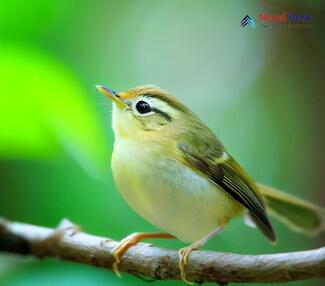Nestled amidst the stunning landscapes of Nepal lies a fascinating species of bird, the Blyth's Leaf Warbler. The Blyth's leaf warbler, or Phylloscopus reguloides, belongs to the leaf warbler family, Phylloscopidae. In the past, it was categorized as part of the "Old World Warbler" group. This species was named in honor of the British zoologist Edward Blyth. This small, understated creature may not immediately catch your eye in contrast to some of its more colorful counterparts, but its presence contributes significantly to the rich biodiversity found within the country. In this article, we will explore the unique characteristics of the Blyth's Leaf Warbler and delve into its behavior, habitat, and importance to Nepal's vibrant ecosystem.
A Look at the Blyth's Leaf Warbler
The Blyth's Leaf Warbler is a small songbird typically measuring around 10 centimeters in length and weighing between 6-9 grams. Boasting a palette of muted greens and browns with an unmistakable golden-yellow hue on its undersides, this bird masterfully blends into its surroundings, making it a challenge for even seasoned birdwatchers to spot.
Natural Habitat and Distribution
Endemic to the rugged terrain and dense forests spanning the lower elevations of the Himalayas in Nepal, the Blyth's Leaf Warbler frequents regions above altitudes of approximately 1500-3700 meters. Apart from Nepal, their range extends through India, Bhutan, China, Myanmar, Thailand, and Vietnam. The leaf warblers are fond of inhabiting mature broadleaved forests, where they deftly navigate through thick foliage in search of insects and other small arthropods.
Behavior and Characteristics
Often heard before they are seen, Blyth's Leaf Warblers emit distinctly melodious songs as they establish their territorial presence throughout their habitats. Additionally, during the breeding season from April to July, these melodic tones become even more pronounced as males actively court potential partners.
Conservation Status
Currently, the International Union for Conservation of Nature (IUCN) lists the Blyth's Leaf Warbler as a species of "Least Concern" due to its widespread distribution and ability to thrive in a variety of environmental conditions. However, ongoing issues such as deforestation and climate change could potentially threaten the stability and future prosperity of this delicate avian species.
In Conclusion
While the Blyth's Leaf Warbler may not demand immediate attention with its modest appearance, its significance to Nepal's wildlife should not be underestimated. The presence of this unassuming bird within the country's lush forests serves as a testament to the incredible biodiversity that thrives in Nepal, offering endless opportunities for nature enthusiasts, photographers, and birdwatchers alike. To truly appreciate this hidden gem, one must venture into Nepal's stunning landscapes with open eyes and ears – sometimes even listening is enough to locate these elusive creatures that grace the intricately woven tapestry of life in this breathtaking region.




